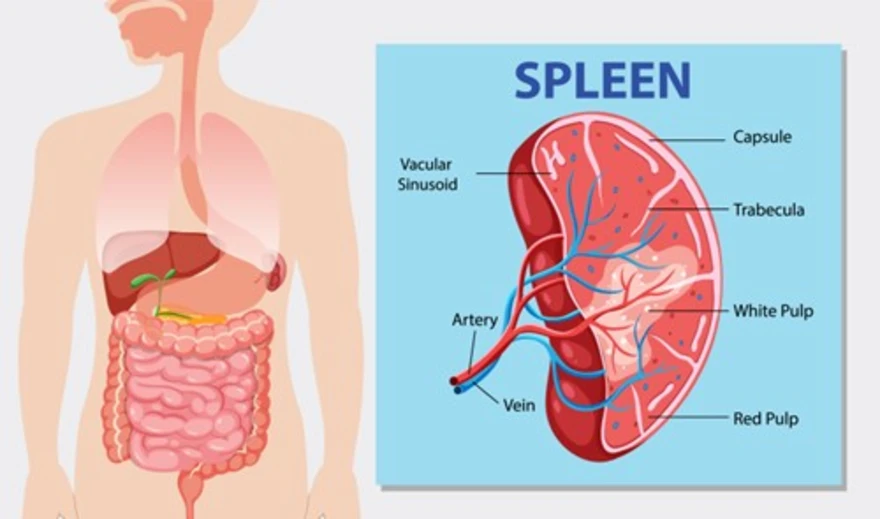Preventive Healthcare
Understanding Ankylosing Spondylitis: Symptoms, Causes & Diagnosis

Table of Contents
If you have been experiencing persistent back pain, stiffness and discomfort that worsens over time, it may be an indication of a chronic inflammatory condition known as Ankylosing Spondylitis. This disease can have a significant impact on your quality of life, making it difficult to perform daily tasks or enjoy physical activities. Understanding the symptoms and causes of this condition is key to managing its effects on your body. In this blog post, we will take a closer look at what this condition is, how it affects the body, possible treatment options and tips for living with it.
What Is Ankylosing Spondylitis?
Ankylosing spondylitis (AS) is a chronic, progressive inflammatory disorder of the spine and sacroiliac joints. The predominant symptom of AS is low back pain that can be accompanied by stiffness and inflammation in other areas of the body, such as the hips, shoulders, and heels. AS can also lead to the fusion of the vertebrae, which can cause a rigid spine.
Ankylosing spondylitis occurs more often in men than women and usually begins in early adulthood. However, children and adolescents can also develop AS.
Symptoms of Ankylosing Spondylitis
Ankylosing Spondylitis (AS) is a chronic inflammatory disease that primarily affects the spine, causing pain and stiffness. It can also affect other joints in the body, such as the hips and shoulders. The symptoms of AS usually develop gradually over time, making it difficult to diagnose early on.
One of the earliest signs of AS is lower back pain that is worse after periods of rest or inactivity. This pain may improve with activity but can become severe if left untreated. Other common symptoms include stiffness and limited mobility in the affected areas, particularly in the morning or after prolonged sitting.
In addition to joint pain and stiffness, some people with AS may experience fatigue, weight loss, fever or anaemia due to inflammation throughout their bodies. As it progresses, it can lead to spinal deformities like kyphosis (forward curvature of the upper back), which can cause difficulty breathing or swallowing.
The most common symptoms are pain and stiffness in the lower back and hips, which can worsen over time. Other symptoms may include:
• Fatigue
• Pain and stiffness in other joints, such as the shoulders, knees, or ankles
• Difficulty moving or bending the spine
• Deformity of the spine over time
• Chest pain or shortness of breath
• Eye inflammation (iritis)
It is important to note that not everyone experiences all these symptoms - they vary from person to person depending on factors like age and gender. If you are experiencing any persistent joint pain or stiffness along with other common symptoms associated with AS, consult your doctor for proper diagnosis and treatment options as soon as possible.
Causes of Ankylosing Spondylitis
The exact cause of Ankylosing Spondylitis is not yet known, but researchers believe that it is a result of a combination of genetic and environmental factors. Studies have shown that there is a strong association between the presence of the HLA-B27 gene and the development of Ankylosing Spondylitis.
This specific gene produces proteins that play an essential role in the body's immune system response. In people with Ankylosing Spondylitis, their immune system mistakenly attacks healthy tissues in their joints and ligaments, causing inflammation and pain.
Aside from genetics, environmental factors like infections or injuries can also trigger the onset of Ankylosing Spondylitis for those who carry the HLA-B27 gene. Smoking has also been found to increase the risk of developing this condition.
Although these factors are associated with Ankylosing Spondylitis, they do not always guarantee its development. It still remains unclear why some individuals develop this condition while others do not even if they carry the HLA-B27 gene or were exposed to certain environmental triggers.
Complications of Ankylosing Spondylitis
Ankylosing spondylitis may cause a few complications:
Uveitis
Uveitis is a serious complication of ankylosing spondylitis that can lead to blindness. It occurs when the immune system attacks the eyes, causing inflammation. Symptoms include eye pain, redness, and blurred vision.
Compression Fractures
Compression fractures are a common complication of ankylosing spondylitis. The condition causes the vertebrae in your spine to fuse, making them less able to support your body weight. This can put pressure on the bones and result in fractures.
Compression fractures can cause pain and stiffness in the affected area. They may also make it difficult to move around. If the fracture is severe, it can lead to deformity or disability.
Heart Ailments
Ankylosing spondylitis can cause major inflammation in the aorta, the biggest artery in the heart. This can eventually deform the shape of the heart and hinder its functioning. Therefore, it can lead to heart disease in the future.
Diagnosing Ankylosing Spondylitis
Diagnosing Ankylosing Spondylitis can be challenging as its symptoms are similar to other conditions such as rheumatoid arthritis and osteoarthritis. However, early diagnosis is crucial in managing the disease and preventing complications.
A physical examination by a healthcare provider may reveal limited spinal mobility, tenderness, or swelling in certain areas of the body. Blood tests may also be performed to check for inflammation markers and genetic testing to look for the HLA-B27 gene linked with an increased risk of developing Ankylosing Spondylitis.
Imaging tests like X-rays, MRIs or CT scans can show changes in the spine and joints that indicate Ankylosing Spondylitis. In some cases, a biopsy of affected tissue may be necessary to confirm the diagnosis.
It is essential to discuss any symptoms with your doctor honestly and openly so they can make an accurate diagnosis. Remember that diagnosing Ankylosing Spondylitis is not always straightforward but working closely with your healthcare team can help you manage your condition effectively.
Treatment Options for Ankylosing Spondylitis
Treatment options for Ankylosing Spondylitis typically focus on managing symptoms and preventing further damage to the spine. The exact treatment plan depends on the severity of the condition, as well as individual factors like age and overall health.
There is a range of options available to treat the symptoms of ankylosing spondylitis (AS). Some common treatment options include:
- Non-steroidal anti-inflammatory drugs (NSAIDs) are often the first line of treatment for AS. These can be taken orally or applied topically. Common NSAIDs used to treat AS include ibuprofen and naproxen. If NSAIDs are not effective in managing AS symptoms, disease-modifying anti-rheumatic drugs (DMARDs) may be prescribed.
- DMARDs work by modulating the immune system and can help to slow down the progression of the disease. Common DMARDs used to treat AS include methotrexate, sulfasalazine, and leflunomide.
- Corticosteroids are another type of medication that can be used to treat a range of inflammatory conditions, including Ankylosing Spondylitis. They work by reducing inflammation and can be taken orally, by injection, or topically. While corticosteroids are generally safe and effective, they can have some side effects, so it’s important to talk to your doctor about whether they’re right for you. Common side effects include weight gain, increased appetite, mood swings, and trouble sleeping.
- Lastly, surgery may also be an option for treating AS in some cases. Surgery is usually only considered when other treatments have failed to relieve symptoms or if there is a significant deformity. Several surgical interventions may be used to treat ankylosing spondylitis, depending on the severity of the condition. In some cases, surgery may be used to fuse the spine, which can help relieve pain and improve mobility. In other cases, surgery may be used to replace joints or to correct deformities. Whatever the type of surgery, it is important to consult with a qualified surgeon.
Living with Ankylosing Spondylitis
Living with Ankylosing Spondylitis can present many challenges, but it is possible to manage the condition and lead a fulfilling life. The first step is to work with your doctor on developing an individualised treatment plan that may include medication, physical therapy, exercise and lifestyle changes.
Many people find relief from pain and stiffness through regular exercises such as swimming or yoga. However, it is important to listen to your body and not push yourself too hard. Resting when needed and taking breaks during activities can help prevent flare-ups of symptoms.
Ankylosing Spondylitis can also impact mental health due to chronic pain and limited mobility. Seeking support from loved ones or joining a support group can help alleviate feelings of isolation or depression.
Making modifications around the house like using ergonomic furniture or installing grab bars in the bathroom can also make daily tasks easier. Additionally, planning for social events by bringing cushions or requesting seating accommodations can allow for participation without exacerbating symptoms.
Living with Ankylosing Spondylitis requires patience and self-compassion while working towards managing symptoms effectively.
Final Take
Ankylosing Spondylitis is a chronic inflammatory disease that can significantly impact the quality of life for those who suffer from it. While there is currently no cure, early diagnosis and treatment can help manage symptoms and prevent further damage. If you experience any of the symptoms associated with Ankylosing Spondylitis or have concerns about your joint health, it is important to speak with your doctor as soon as possible.
If you have further concerns about this condition or are looking for an accurate test, contact us at Metropolis Healthcare today. Our labs are equipped with the best technology and know-how to conduct accurate ESR Automated Blood Test. Book an appointment today!


























